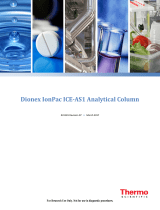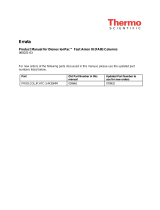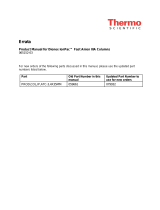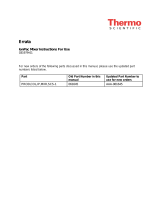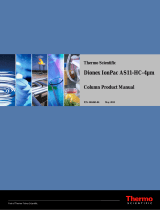Page is loading ...

Errata
Product Manual for Dionex IonPac™ ICE-AS6 Columns
034961-07
For new orders of the following parts discussed in this manual, please use the updated part
numbers listed below.
Part Old Part Number in this
manual Updated Part Number to
use for new orders
PROD,COL,IP,ICE-AS6 046023 079798

IonPac® ICE-AS6

IonPac ICE-AS6 Manual Doc. No. 034961-07 Page 1 of 47
PRODUCT MANUAL
for the
IONPAC® ICE-AS6 ANALYTICAL COLUMN
(9 x 250 mm, P/N 046023)
©DIONEX Corporation 2005
Document No. 034961
Revision 07
29 August 2005

IonPac ICE-AS6 Manual Doc. No. 034961-07 Page 2 of 47
TABLE OF CONTENTS
SECTION 1 - IONPAC ICE-AS6 ION EXCLUSION CHROMATOGRAPHY ......................... 5
SECTION 2 - IONPAC ICE-AS6 EXCLUSION CHROMATOGRAPHY SYSTEM ................ 7
SECTION 3 - INSTALLATION .................................................................................................... 8
3.1 System Requirements ........................................................................................................................................... 8
3.2 System Void Volume .............................................................................................................................................. 8
3.3 The Injection Loop ................................................................................................................................................. 8
3.4 Eluent Storage ....................................................................................................................................................... 8
3.5 Anion MicroMembrane Suppressor-ICE II Requirements .................................................................................. 9
SECTION 4 - OPERATION ........................................................................................................ 10
4.1 General Operating Conditions ........................................................................................................................... 10
4.1.1 IonPac ICE-AS6 Operation Precautions ............................................................................................................... 10
4.1.2 Solvents ............................................................................................................................................................... 10
4.2 Chemical Purity Requirements .......................................................................................................................... 12
4.2.1 Inorganic Chemicals ............................................................................................................................................. 12
4.2.2 Solvents ............................................................................................................................................................... 12
4.2.3 Deionized Water ................................................................................................................................................... 12
4.3 Eluent Preparation .............................................................................................................................................. 12
4.3.1 Acid Eluent Preparation ....................................................................................................................................... 12
4.4 Eluents Containing Solvents .............................................................................................................................. 12
4.5 Anion Suppression Regenerant Preparation ..................................................................................................... 13
4.6 Organic Acid Standard Solution Preparation .................................................................................................... 13
SECTION 5 - EXAMPLE APPLICATIONS ............................................................................... 14
5.1 Preparation of Eluents ........................................................................................................................................ 14
5.2 pKa Values of Selected Organic Acids ............................................................................................................... 14
5.3 ICE-AS6 Elution Plots ......................................................................................................................................... 17
5.3.1 ICE-AS6 Retention Time vs. Eluent Strength ....................................................................................................... 17
5.3.2 ICE-AS6 Retention Time vs. Temperature ............................................................................................................ 18
5.4 Production Test Chromatogram ......................................................................................................................... 19
5.5 Full IonPac ICE-AS6 Organic Acid Chromatogram .......................................................................................... 20

IonPac ICE-AS6 Manual Doc. No. 034961-07 Page 3 of 47
5.6 Comparison of Different Acids Used on the IonPac ICE-AS6 ............................................................................ 21
5.7 Retention Times Versus Eluent acid Concentration .......................................................................................... 22
5.8 Analysis of a Coffee Sample ............................................................................................................................... 23
5.9 Fouling Resistance of IonPac ICE-AS6 Columns .............................................................................................. 24
5.10 Analysis of Milk .................................................................................................................................................. 25
5.11 Analysis of Wine Samples .................................................................................................................................. 26
5.12 Analysis of Jack Daniels Lynchburgh Lemonade ............................................................................................. 27
5.13 Analysis of Beer Samples ................................................................................................................................... 28
5.14 Analysis of Fruit Juice Samples ........................................................................................................................ 29
5.15 Analysis of Tomato Product Samples ................................................................................................................. 31
5.16 Analysis of Mustard ............................................................................................................................................ 32
5.17 Analysis of Boric Acid and Carbonic Acid ......................................................................................................... 33
5.18 Analysis of 0.25% Sulfuric Acid ....................................................................................................................... 34
5.19 Analysis of 0.50% Sodium Chloride ................................................................................................................. 35
5.20 Comparison of UV versus Suppressed Conductivity Detection ......................................................................... 36
5.21 Detection of Alcohols Using Pulse Amperometric Detection ............................................................................ 37
5.22 Analysis of Selected Inorganic Ions ................................................................................................................... 38
SECTION 6 - TROUBLESHOOTING GUIDE .......................................................................... 39
6.1 High Back Pressure ........................................................................................................................................... 40
6.1.1 Finding the Source of High System Pressure....................................................................................................... 40
6.1.2 Replacing Column Bed Support Assemblies ........................................................................................................ 40
6.2 High Background or Noise ................................................................................................................................. 41
6.2.1 Preparation of Eluents .......................................................................................................................................... 41
6.2.2 A Contaminated Guard or Analytical Column ...................................................................................................... 41
6.2.3 Contaminated Hardware ....................................................................................................................................... 41
6.2.4 A Contaminated Anion-ICE MicroMembrane Suppressor II, AMMS-ICE II ........................................................ 41
6.3 Poor Peak Resolution ......................................................................................................................................... 42
6.3.1 Loss of Column Efficiency ................................................................................................................................... 42
6.3.2 Poor Resolution Due to Shortened Retention Times ........................................................................................... 42
6.3.3 Loss of Front End Resolution .............................................................................................................................. 42
6.4 Spurious Peaks ................................................................................................................................................... 43
6.5 Split Peaks .......................................................................................................................................................... 43

IonPac ICE-AS6 Manual Doc. No. 034961-07 Page 4 of 47
APPENDIX A - QUALITY ASSURANCE REPORT .................................................................. 44
APPENDIX B - COLUMN CARE .............................................................................................. 46
Recommended Operation Pressures ............................................................................................................................. 46
Column Start-Up ............................................................................................................................................................ 46
Column Storage ............................................................................................................................................................. 46
Column Conditioning ..................................................................................................................................................... 46
Column Cleanup ............................................................................................................................................................ 46
Choosing the Appropriate Cleanup Solution ................................................................................................................ 47
Column Cleanup Procedure .......................................................................................................................................... 47

IonPac ICE-AS6 Manual Doc. No. 034961-07 Page 5 of 47
SECTION 1 - IONPAC ICE-AS6 ION EXCLUSION CHROMATOGRAPHY
The IonPac ICE-AS6 is an ion exclusion column designed for efficient separation of low molecular weight aliphatic organic
acids including hydroxy- substituted organic acids, aliphatic alcohols and glycols.
The IonPac ICE-AS6 is uses an ion exclusion mechanism, Donnan exclusion (see Figure 1, “The Ion Exclusion Separation”),
which allows retention and separation of weakly ionized acids based on differences in pKa’s. Strong inorganic acid anions are
not retained by the stationary phase and elute in the void volume of the column. In addition to Donnan exclusion, the ICE-
AS6 has hydrophobic functional groups within the resin structure which promote adsorption and hydrogen bonding. These
two additional retention mechanisms allow resolution of organic acids which are poorly resolved by ion exclusion alone, such
as tartrate (pK1 = 2.82) from citrate (pK1 = 2.87) and glycolate (pK1 = 3.63) from lactate (pK1 = 3.66) from hydroxyisobutyric acid
(pK1 = 3.72).
In the ion exclusion mechanism shown in Figure 1, “The Ion Exclusion Separation,” below, the sulfonated surface is a
hydrated, negatively charged boundary called a Donnan membrane which is permeable only to neutral molecules. Totally
dissociated inorganic acids, such as dilute hydrochloric acid, can not penetrate the membrane due to electrostatic repulsion
and are totally excluded from the stationary phase. This volume is called the exclusion volume, Ve. In contrast, neutral
molecules can diffuse into the resin pores. The total permeation volume, Vp, for water is observed as a small negative peak.
The undissociated form of a weak carboxylic acid exhibits a greater retention than water due to adsorption to the resin. In
general, the higher the pKa of the acid, the greater the retention. The longer the aliphatic carboxylic acid, the longer its
retention time. On the ICE-AS6, the adsorption mechanism, in addition to Donnan exclusion, is very significant. The addition
of a solvent such as acetonitrile can be used to reduce retention times of highly retained hydrophobic carboxylic acids.
Stronger carboxylic acids such as di- and tricarboxylic acids (i.e. oxalic or citric) have low retention and elute between the
exclusion and total permeation volumes.
Figure 1
The Ion Exclusion Separation
SO H
3
_+
SO H
3
_+
SO H
3
_+
SO H
3
_+
COO H
_+
COO H
_+
SO H
3
_+
CO
OHC
O
O
HR
Hydrogen Bonding
COO H
_+
Donnan Membrane
Stationary
Phase Mobile
Phase
H O
2
H O
2
H X
+
Eluent
_
RCOO H
_+
δ-

IonPac ICE-AS6 Manual Doc. No. 034961-07 Page 6 of 47
Always remember that assistance is available for any problem that may be encountered during the shipment
or operation of DIONEX instrumentation and columns through any of the DIONEX Worldwide Offices listed
in “DIONEX Worldwide Offices.”
ICE-AS6 columns are stable between pH 0 - 7 (do not run eluents with cations other than hydronium ion through the ICE-
AS6) and are compatible with eluents containing 0 - 15% HPLC solvents such as methanol, acetonitrile or 5% isopropanol.
The ICE-AS6 is composed of a 8 µm cross-linked styrene/acrylate/divinylbenzene resin which is functionalized to produce
sulfonate and carboxylate groups. The ion exchange capacity of the 9 x 250 mm analytical column is 27 meq/column. The IonPac
ICE-AS6 also has intermediate hydrophobicity when compared to the ICE-AS1. The ICE-AS6 also has intermediate solvent
compatibility (15%) when compared to the ICE-AS1 (50%).
The ICE-AS6 can be operated at flow rates up to 1.25 mL/min. When setting up the analytical system, observe the special
precautions listed in Section 3, “Installation.” PEEK (polyetheretherketone) is used to make column hardware. PEEK has
excellent chemical resistance to most organic solvents and inorganic solutions. Concentrated sulfuric acid and concentrated
nitric acid will attack PEEK. Tetrahydrofuran at concentrations of greater than 15% is not compatible with PEEK systems. The
ICE-AS6 Analytical Columns have minimum efficiencies for sulfate of 12,000 plates/column (for acetic acid), under standard
operating conditions. The ICE-AS6 operates at a back pressure between 400-600 psi (2.76-4.14 MPa) at 1.0 mL/min with the test
eluent. However, the column is capable of operating at back pressures up to 900 psi (6.20 MPa).
This manual assumes that you are familiar with the installation and operation of the DIONEX Ion Chromatograph (IC) and the
AMMS-ICE MicroMembrane™ Suppressor. If you do not understand the operation of the system, take the time to familiarize
yourself with the various system components before beginning an analysis.
The IonPac ICE-AS6 Analytical Column has 10-32 threaded PEEK end fittings for use with ferrule/bolt liquid line fittings. If
your system is otherwise configured, refer to, “DIONEX Liquid Line Fittings.”

IonPac ICE-AS6 Manual Doc. No. 034961-07 Page 7 of 47
SECTION 2 - IONPAC ICE-AS6 EXCLUSION CHROMATOGRAPHY SYSTEM
Condition Operation Summary
Eluent Flow Rate: Typically 1.0 mL/min
Anion MicroMembrane: Anion-ICE MicroMembrane Suppressor II, AMMS-ICE II (P/N 037107)
Do not run the AMMS-ICE II Suppressor over 40°C.
Place outside of oven if application requires higher temperatures
Injection Loop: 10 - 50 µL
System Void Volume: Minimize dead volumes. Switching valves, couplers can be used.
The GM-3 Gradient Mixer should be used for gradient analysis on systems
other than DX-300 HPLC Pump.
Detectors: AD20 or AD25 Absorbance Detector (10 µL, 6-mm)
CD20 or CD25 Conductivity Detector (9 µL, 10 mm or 7.5 µL, 6-mm)
with a DS3 Temperature Controller (P/N 44130)
DIONEX Back pressure Regulator 75 psi (0.52 MPa) rating ( P/N 039760)
or Tubing (see Table 1)
Ensure 50 - 75 psi (0.34-0.52 MPa) back pressure.
Either the TS-1 or the TS-2 can be used.

IonPac ICE-AS6 Manual Doc. No. 034961-07 Page 8 of 47
SECTION 3 - INSTALLATION
3.1 System Requirements
The IonPac ICE-AS6 Analytical Column is designed to be run on any DIONEX Ion Chromatograph equipped with suppressed
conductivity detection.
3.2 System Void Volume
For best performance, all of the tubing installed between the injection valve and detector should be 0.005" (P/N 044221) ID
PEEK tubing or 0.010" ID PEEK tubing (P/N 042260). Minimize the lengths of all connecting tubing and remove all
unnecessary switching valves and couplers. If you need assistance in properly configuring your system contact the DIONEX
Worldwide Office nearest you (see “DIONEX Worldwide Offices”).
3.3 The Injection Loop
Table 1
Smallest Injectable Volumes (µL)
For most applications on a 4-mm analytical system, a 10 - 50 µL injection loop will be sufficient. DIONEX recommends that a
50 µL injection loop be used.
3.4 Eluent Storage
IonPac ICE-AS6 columns are designed to be used with acid eluent systems and isocratic analysis. Storage under a helium
atmosphere ensures contamination free operation and proper pump performance (nitrogen can be used if eluents do not
contain solvents). Acidic eluents that contain acetonitrile should be made fresh daily. Acetonitrile slowly hydrolyzes in acidic
solutions.
Valve Type Using 0.012" ID
Tefzel Tubing
Using 0.007" ID
Tefzel Tubing
Using 0.010" ID
PEEK Tubing
Using 0.005" ID
PEEK Tubing
DIONEX
BF2 Valve
(8 µL Internal Volume)
(10 cm Loop)
15.2 10.5 13.1 9.2
DIONEX
MicroInject Valve
(10.5 µL Internal Volume)
(14 cm Loop)
20.5 14.0 17.6 12.2
Rheodyne
Microinjection Valve
Model 9126
(0.8 µL Internal Volume)
(10 cm Loop)
8.0 3.3 5.9 2.0

IonPac ICE-AS6 Manual Doc. No. 034961-07 Page 9 of 47
3.5 Anion MicroMembrane Suppressor-ICE II Requirements
An Anion-ICE MicroMembrane Suppressor II (AMMS-ICE II, P/N 037107) should be used instead of an ASRS-ULTRA or
AMMS III for ion exclusion applications that require suppressed conductivity detection. It is compatible with all solvents and
concentrations with which the systems and columns are compatible. Use DIONEX Cation Regenerant Solution,
Tetrabutylammonium hydroxide (TBAOH, P/N 039602). Dilute as required for the example applications.
This manual assumes that you are familiar with the installation and operation of the Ion Chromatograph and the AMMS-ICE
II Suppressor. If you do not understand the operation of your system, take the time to familiarize yourself with the operator’s
manuals for the products before beginning an analysis. For detailed information on the operation of the AMMS-ICE II
Suppressor, see Document No. 03266.

IonPac ICE-AS6 Manual Doc. No. 034961-07 Page 10 of 47
SECTION 4 - OPERATION
4.1 General Operating Conditions
The selectivity of the IonPac ICE-AS6 Analytical Column has been designed to separate a broad range of low molecular
weight organic acid anions in less than 20 minutes. The ICE-AS6 column consists of a cross-linked (8%), microporous,
intermediate hydrophobic resin that has been sulfonated. The nature of the cross-linked polymeric structure of the packing
material makes ICE-AS6 columns compatible with pH 0 - 7 eluents (see Section 4.1.1, “IonPac ICE-AS6 Operation
Precautions) and 0 - 15% organic solvent eluents. The ICE-AS6 can be used with any suppressible ionic eluent that does not
exceed the capacity of the AMMS-ICE II.
4.1.1 IonPac ICE-AS6 Operation Precautions
CAUTION
15% maximum Solvent Concentration
When using solvents over 5%, use a gradient over 30 minutes to achieve the maximum solvent concentration (a step
change will cause fronting). When the maximum concentration of solvent is achieved, rinse the column for at least 30
minutes.
DO NOT use hydroxide eluents
Filter and Degas Eluents
Filter Samples
Maximum Recommended Operating Pressure is 900 psi (6.20 Mpa)
4.1.2 Solvents
The ICE-AS6 column is more sensitive to solvents than the ICE-AS1 column. It is recommended that only acetonitrile or
methanol be used in either eluents or cleanup solutions. See “Column Care” for recommended cleanup approaches. The
maximum amount recommended is 15% of either acetonitrile or methanol, and only as a last resort. Try starting with 5% at
first and then increment by 5% for each experiment (up to but not higher than 15%). Make sure that for amounts higher than
5%, you use a 30-minute gradient to reach the desired concentration (see Section 4.1.1, “IonPac ICE-AS6 Operation
Precautions” above). Use a gradient to ramp back down as well, otherwise the column may be damaged. After returning to
100% aqueous it will take about an hour to achieve a stable baseline. The ICE-AS6 column is moderately hydrophobic and
therefore solvents take longer to wash out before achieving equilibration.
Solvents and water should be premixed in concentrations to allow proper mixing by the gradient pump and to minimize
outgassing. Ensure that all of the inorganic chemicals are soluble in the highest solvent concentration to be used during the
analysis.
When using a solvent in an ionic eluent, column generated back pressures will depend on the solvent used, concentration of
the solvent, the ionic strength of the eluent and the flow rate used. The column back pressure will vary as the composition of
water-methanol and water-acetonitrile mixture varies. The practical back pressure limit for the IonPac ICE-AS6 columns is 900
psi (6.20 MPa).

IonPac ICE-AS6 Manual Doc. No. 034961-07 Page 11 of 47
Table 2
HPLC Solvents for Use with IonPac ICE-AS6 Columns
Solvent Maximum Operating
Concentration*
Acetonitrile 15%
Methanol 15%
Isopropanol 5%
* See Section 4.1.1, “IonPac ICE-AS6 Operation Precautions.”

IonPac ICE-AS6 Manual Doc. No. 034961-07 Page 12 of 47
4.2 Chemical Purity Requirements
Obtaining reliable, consistent and accurate results requires eluents that are free of ionic and spectrophotometric impurities.
Chemicals, solvents and deionized water used to prepare eluents must be of the highest purity available. Maintaining low trace
impurities and low particle levels in eluents also help to protect your ion exchange columns and system components. DIONEX
cannot guarantee proper column performance when the quality of the chemicals, solvents and water used to prepare eluents
has been compromised.
4.2.1 Inorganic Chemicals
Reagent Grade inorganic chemicals should always be used to prepare ionic eluents. Whenever possible, inorganic chemicals
that meet or surpass the latest American Chemical Society standard for purity should be used. These inorganic chemicals will
detail the purity by having an actual lot analysis on each label. The analyses performed in Section 5, “Example Applications,”
use heptafluorobutyric acid obtained from Fluka Chemie AG.
4.2.2 Solvents
Since solvents used with the IonPac ICE-AS6 columns are added to ionic eluents to modify the ion exclusion process, the
solvents used must be free of ionic impurities. However, since most manufacturers of solvents do not test for ionic impurities,
it is important that the highest grade of solvents available be used. Currently, several manufacturers are making “ultrahigh”
purity solvents that are compatible for HPLC and spectrophotometric applications. These “ultrahigh” purity solvents will
usually ensure that your chromatography is not affected by ionic impurities in the solvent. Currently at DIONEX, we have
obtained consistent results using High Purity Solvents manufactured by Burdick and Jackson and Optima Solvents by Fisher
Scientific.
4.2.3 Deionized Water
The deionized water used to prepare eluents should be Type I Reagent Grade Water with a specific resistance of 18.2
megohm-cm. The deionized water should be free of ionized impurities, organics, microorganisms and particulate matter larger
than 0.2 µm. Bottled HPLC-Grade Water (with the exception of Burdick & Jackson) should not be used since most bottled water
contains an unacceptable level of ionic impurities.
4.3 Eluent Preparation
4.3.1 Acid Eluent Preparation
The acidic eluents used with the IonPac ICE-AS6 columns are stable and require no special storage. Always prepare eluents
with Type I Reagent Grade Water (see Section 4.2.3, “Deionized Water”) the has been properly degassed (see Section 4.3.2,
“Degassing Deionized Water”).
4.4 Eluents Containing Solvents
When mixing solvents with water remember to mix solvent with water on a volume to volume basis. If a procedure requires an
eluent of 10% acetonitrile, prepare the eluent by adding 100 mL of acetonitrile to an eluent reservoir. Then add 900 mL of
deionized water to the acetonitrile in the reservoir. Using this procedure to mix solvents with water will ensure that a consistent
true volume/volume eluent is obtained. Premixing water with solvent will minimize the possibility of outgassing.
As a rule degass the aqueous component of the eluent and then add the solvent component. Avoid
excessive purging or degassing of eluents containing solvents if possible, since it is possible that a
volatile solvent can be “boiled” off from the solution.
NOTE

IonPac ICE-AS6 Manual Doc. No. 034961-07 Page 13 of 47
4.5 Anion Suppression Regenerant Preparation
The regenerant used with the AMMS-ICE II Suppressor when used with the IonPac ICE-AS6 to perform the analyses in
Section 5, “Example Applications,” is 5 mM tetrabutylammonium hydroxide (TBAOH). Use DIONEX Cation Regenerant
Solution (P/N 039602). Dilute 50 mL of the 0.1 M Cation Regenerant Solution to 1 L with degassed Type I Reagent Grade
Water. Prepare several liters of the regenerant.
For a guide to properly adjusting the regenerant flow rate, see Document No. 032661, the Product Manual for the AMMS-ICE
II.
4.6 Organic Acid Standard Solution Preparation
For ion exclusion chromatography, the acid forms of organic acids are typically use to prepare standards rather than the
sodium or potassium salts.

IonPac ICE-AS6 Manual Doc. No. 034961-07 Page 14 of 47
The chromatograms in this section were obtained using columns that reproduced the Production test
Chromatogram (see Section 5.3, “Production Test Chromatogram”) on optimized Ion
Chromatographs (see Section 3, “Installation”). Different systems will differ slightly in performance
due to slight differences in column sets, system void volumes, liquid sweep-out times of different
components and laboratory temperatures.
SECTION 5 - EXAMPLE APPLICATIONS
The IonPac ICE-AS6 may be used isocratically for chromatographing a large number of carboxylic acids.
If your sample or standard contains organic acids, adding chromate (about 10 mg/L) will help stabilize them from bacterial
degradation at room temperature.
Before attempting any of the following example applications, take the time to ensure that your system is properly configured.
Ensure that all of the eluents have been made from high purity reagents and deionized water. All water used in the preparation
of eluents should be degassed, deionized water. For chemical purity requirements see Section 4.2, “Chemical Purity
Requirements.”
Run synthetic standards to calibrate and confirm the operation of your system. This column has a very high loading capacity
and can handle a large number of dirty samples. If after running complex samples, the ICE-AS6 shows signs of fouling, refer
to the column cleanup protocols in, “Column Care.”
5.1 Preparation of Eluents
The standard eluent for the example applications presented in this section is 0.4 mM heptafluorobutyric acid. It was prepared
from heptafluorobutyric acid (same as perfluorobutyric acid) obtained from FLUKA Chemie AG (P/N 77249). It is >99% (GC)
purity with a molecular weight of 214.04 and a density of 1.652. It is supplied in 10.0 mL bottles (16.52 g).
Heptafluorobutyric Acid Stock Solution (0.0772 M): Dilute the entire contents of one 10.0 mL bottle to 1 L.
Heptafluorobutyric Acid Eluent (0.4 mM): Dilute 5.2 g of the stock solution (0.0772 M) to 1 L.
If you prefer to work from a 0.100 M stock solution, dilute 21.40 g of the >99% purity heptafluorobutyric acid to 1 L. The eluent
can then be made by diluting 4.0 g of the 0.100 M stock solution to 1 L to obtain the 0.4 mM heptafluorobutyric acid eluent.
Heptafluorobutyric acid was chosen for minimum background conductivity. However, other 0.4 mM monoprotic acids can be
used (see Section 5.5, “Comparison of Different acids used on the IonPac ICE-AS6”).
5.2 pKa Values of Selected Organic Acids
The following tables list the pKs of selected organic acids in alphabetical order and in ascending order of pK. Organic acids
elute in approximately the order of ascending pK but additional hydrogen bonding and adsorption variables modify the
elution order slightly so that the elution order of the acids is not strictly in order of ascending pK. The tables plus the example
applications are designed to give the chromatographer a simple method for estimated the ability of the ICE-AS6 to separate
various combinations of organic acids.
NOTE

IonPac ICE-AS6 Manual Doc. No. 034961-07 Page 15 of 47
Table 3
Organic Acids with pKa Values In Order of Increasing pK1
Compound pK1pK2pK3
Terephthalic
Squaric (3,4-dihydroxy-3-cyclobutene-1,2-dione 0.40 3.10
Trichloroacetic 0.66
Mellitic (benzenehexacarboxylic) 0.70 2.21 3.52
Dichloroacetic 0.87
Oxalic (ethanedioic) 1.04 3.82
Nitroacetic 1.46
Maleic (cis-butenedioic) 1.75 5.83
Ketoglutaric (2-oxopentanedioic) 1.85 4.44
Orotic (uracil-6-carboxylic) 1.96 9.34
Citraconic (cis-methylbutenedioic) 2.20 5.60
Pyruvic (2-oxopropanoic) 2.26
Trimellitic (benzene-1,2,4-tricarboxylic) 2.40 3.71 5.01
Fluoroacetic 2.59
Mesaconic (trans-methylbutene) 2.61
Cyanoacetic 2.63
Malonic (propanedioic) 2.65 5.28
Chloroacetic 2.68
Gentistic (5-hydroxysalicylic) 2.70
Dithiotartaric (2,3-dimercaptobutanedioic) 2.71 3.48 8.89
Bromoacetic 2.72
Phthalic (benzene-1,2-dicarboxylic) 2.75 4.93
Diglycolic (oxydiacetic) 2.79 3.93
Salicylic (2-hydroxybenzoic) 2.81 13.40
Tartaric (d-2,3-dihydroxybutanedioic) 2.82 3.95
Fumaric (trans-butenedioic) 2.85 4.10
Citric (2-hydroxypropane-1,2,3-tricarboxylic) 2.87 4.35 5.69
Iodoacetic 2.98
Isocitrate (dl-1-hydroxypropane-1,2,3-tricarboxylic) 3.02 4.28 5.75
Mucic 3.08 3.63
Mandelic (l-phenylhydroxyacetic) 3.19
Galacturonic 3.23 11.42
Malic (l-hydroxybutanedioic) 3.24 4.71
Thiomalic (dl-mercaptobutanedioic) 3.30 4.60 10.38
Quinic (1,3,4,5-tetrahydroxycyclohexanecarboxylic) 3.36
Thioglycolic (mercaptoacetic) 3.42 10.11
Thiolactic (dl-2-mercaptopropanoic) 3.48 10.08
Hippuric (n-benzoylglycine) 3.50
Glyceric (dl-2,3-dihydroxypropanoic) 3.52
Formic (methanoic) 3.55
Glycolic (hydroxyacetic) 3.63
Lactic (d-2-hydroxypropanoic) 3.66
Itaconic (methylenebutanedioic) 3.68 5.14
2-Hydroxyisobutyric 3.72
Benzoic 4.00
Succinic (butanedioic) 4.00 5.24
Ascorbic 4.03 11.34
4-Hydroxybenzoic 4.10 9.96
Vinylacetic (but-3-enoic) 4.12
Glutaric (pentanedioic) 4.13 5.03
Acrylic (propenoic) 4.26
Adipic (hexanedioic) 4.26 5.03
Pimelic (heptanedioic) 4.31 5.08
3-Mercaptopropanoic 4.34 10.84
Azelaic (nonanedioic) 4.39 5.12
Anisic (4-methoxybenzoic) 4.48
Acetic (ethanoic) 4.56
Isovaleric (3-methylbutanoic) 4.58
Butanoic 4.63
Isobutyric (2-methylpropionic) 4.63
Valeric (pentanoic) 4.64
Propanoic 4.67
Crotonic (trans-but-2-enoic) 4.69
Pivalic (2,2-dimethylpropanoic) 4.83
Caproic (hexanoic) 4.85
Octanoic 4.89
Uric (2,6,8-trihydroxypurine) 5.61
Guanidine 13.54

IonPac ICE-AS6 Manual Doc. No. 034961-07 Page 16 of 47
Table 4
Organic Acids with pKa Values in Alphabetic Order
Compound pK1pK2pK3
Acetic (ethanoic) 4.56
Acrylic (propenoic) 4.26
Adipic (hexanedioic) 4.26 5.03
Anisic (4-methoxybenzoic) 4.48
Ascorbic 4.03 11.34
Azelaic (nonanedioic) 4.39 5.12
Benzoic 4.00
Bromoacetic 2.72
Butanoic 4.63
Caproic (hexanoic) 4.85
Chloroacetic 2.68
Citraconic (cis-methylbutenedioic) 2.20 5.60
Citric (2-hydroxypropane-1,2,3-tricarboxylic) 2.87 4.35 5.69
Crotonic (trans-but-2-enoic) 4.69
Cyanoacetic 2.63
Dichloroacetic 0.87
Diglycolic (oxydiacetic) 2.79 3.93
Dithiotartaric (2,3-dimercaptobutanedioic) 2.71 3.48 8.89
Fluoroacetic 2.59
Formic (methanoic) 3.55
Fumaric (trans-butenedioic) 2.85 4.10
Galacturonic 3.23 11.42
Gentistic (5-hydroxysalicylic) 2.70
Glutaric (pentanedioic) 4.13 5.03
Glyceric (dl-2,3-dihydroxypropanoic) 3.52
Glycolic (hydroxyacetic) 3.63
Guanidine 13.54
2-Hydroxyisobutyric 3.72
4-Hydroxybenzoic 4.10 9.96
Hippuric (n-benzoylglycine) 3.50
Iodoacetic 2.98
Isobutyric (2-methylpropionic) 4.63
Isocitrate (dl-1-hydroxypropane-1,2,3-tricarboxylic) 3.02 4.28 5.75
Isovaleric (3-methylbutanoic) 4.58
Itaconic (methylenebutanedioic) 3.68 5.14
Ketoglutaric (2-oxopentanedioic) 1.85 4.44
Lactic (d-2-hydroxypropanoic) 3.66
Maleic (cis-butenedioic) 1.75 5.83
Malic (l-hydroxybutanedioic) 3.24 4.71
Malonic (propanedioic) 2.65 5.28
Mandelic (l-phenylhydroxyacetic) 3.19
Mellitic (benzenehexacarboxylic) 0.70 2.21 3.52
3-Mercaptopropanoic 4.34 10.84
Mesaconic (trans-methylbutene) 2.61
Mucic 3.08 3.63
Nitroacetic 1.46
Octanoic 4.89
Orotic (uracil-6-carboxylic) 1.96 9.34
Oxalic (ethanedioic) 1.04 3.82
Phthalic (benzene-1,2-dicarboxylic) 2.75 4.93
Pimelic (heptanedioic) 4.31 5.08
Pivalic (2,2-dimethylpropanoic) 4.83
Propanoic 4.67
Pyruvic (2-oxopropanoic) 2.26
Quinic (1,3,4,5-tetrahydroxycyclohexanecarboxylic) 3.36
Salicylic (2-hydroxybenzoic) 2.81 13.40
Squaric (3,4-dihydroxy-3-cyclobutene-1,2-dione 0.40 3.10
Succinic (butanedioic) 4.00 5.24
Tartaric (d-2,3-dihydroxybutanedioic) 2.82 3.95
Terephthalic
Thioglycolic (mercaptoacetic) 3.42 10.11
Thiolactic (dl-2-mercaptopropanoic) 3.48 10.08
Thiomalic (dl-mercaptobutanedioic) 3.30 4.60 10.38
Tricarballylic 3.48 4.50 5.82
Trichloroacetic 0.66
Trimellitic (benzene-1,2,4-tricarboxylic) 2.40 3.71 5.01
Uric (2,6,8-trihydroxypurine) 5.61
Valeric (pentanoic) 4.64
Vinylacetic (but-3-enoic) 4.12

IonPac ICE-AS6 Manual Doc. No. 034961-07 Page 17 of 47
5.3 ICE-AS6 Elution Plots
5.3.1 ICE-AS6 Retention Time vs. Eluent Strength
The following plot illustrates the effect of eluent strength on retention time for a large group of low molecular weight organic
acids. Predicted separations can be obtained from a plot of column selectivity versus eluent strength. The actual resolution of
separation though is also dependent on the efficiency of the column.
Below 0.2 mM Heptafluorobutyric acid (PFBA), the retention times of all of the analytes fall off very quickly. On close
examination, there is a minimum eluent concentration required to maintain peak symmetry which in this case is also
approximately 0.2 mM heptafluorobutyric acid.
Figure 2
ICE-AS6 Retention Time vs. Eluent Strength

IonPac ICE-AS6 Manual Doc. No. 034961-07 Page 18 of 47
5.3.2 ICE-AS6 Retention Time vs. Temperature
Temperature can effect the retention time and the selectivity of organic acids. Dionex tests all ion-exclusion columns at 19°C
to ensure reproducible retention times. As can be seen from the plot below, retention times decrease slightly with increasing
temperature. For example, glutaric and propionic acids switch elution order at approximately 35°C and succinic and acetic at
30°C. Fumaric acid is also strongly effected showing a very rapid decrease in run time with increasing temperature.
Laboratories can have widely varying temperatures throughout the day (some as high as ±5°C), it is advisable to use
temperature control to maintain reproducible retention times. This can be done with any of the Dionex temperature control
devices such as the LC30, LC25, or the AS50 Thermal Compartment. If a temperature control device is not available, it is
recommended to keep the system away from any heating/cooling vents located in the laboratory to minimize wide temperature
swings. This will keep wide temperature swings to a minimum within the column area. See section 5.6.3 for comparison runs.
20 30 40 50 60 70 80
4
6
8
10
12
14
16
18
20
22
24
26
28
30 ICE-AS6: Run Times vs. Temperature
12 Tartrate
11 Citrate
10 Malate
9 Glycolate
8 Formate
7 Lactate
6 HIBA
5 Acetate
4 Succinate
12
11
10
9
8
7
6
5
4
3
2
12 Propionate
1 Glutarate
3 Fumarate
Run Time Minutes
Temperature C
Figure 3
ICE-AS6 Retention Time vs. Temperature
/
